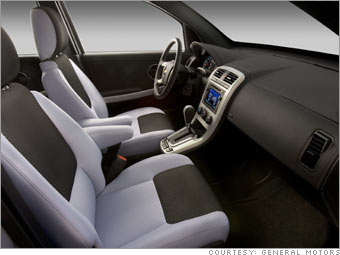Honda will soon begin leasing a few dozen examples of its latest Honda FCX fuel cell cars to customers. This new FCX will be unveiled in November at the Los Angeles Auto Show.
While the technology clearly exists to produce a safe zero-emission vehicle that fits the practical needs of car buyers, there are two remaining challenges that must be overcome before hydrogen-powered cars are in every American driveway.
First, they must be cheaper to produce. Much cheaper. Neither Honda or GM will disclose the actual cost of producing their respective fuel cell vehicles but, clearly, costs are much too high to make any business sense. The lease rates Honda will be charging for the FCX will be nominal compared to the car's actual cost.
Cost-cutting efforts are focused on the fuel cell, GM says, which uses costly platinum, and the hydrogen storage tanks, which use carbon fiber and have complex valves.
Longevity is another major issue. Right now, GM expects an Equinox Fuel Cell vehicle to run reliably for about 50,000 miles. For a commercially viable car, GM wants to get that number up to at least 150,000 miles.
The biggest challenge of GM's E-Flex concept will be creating batteries strong enough to hold and release the large amounts of power needed to actually drive a car at full speed.
Finally, there's the problem of where to get compressed hydrogen fuel. GM, in cooperation with Shell, is working on a strategy of peppering major metropolitan areas with hydrogen filling stations so that early adopters will have somewhere to fill up even if it's a tad inconvenient.
Once those first stations are in place as a "proof of concept," the hope is that others will follow making fill-ups less inconvenient so that, in turn, more people embrace hydrogen-powered cars.

